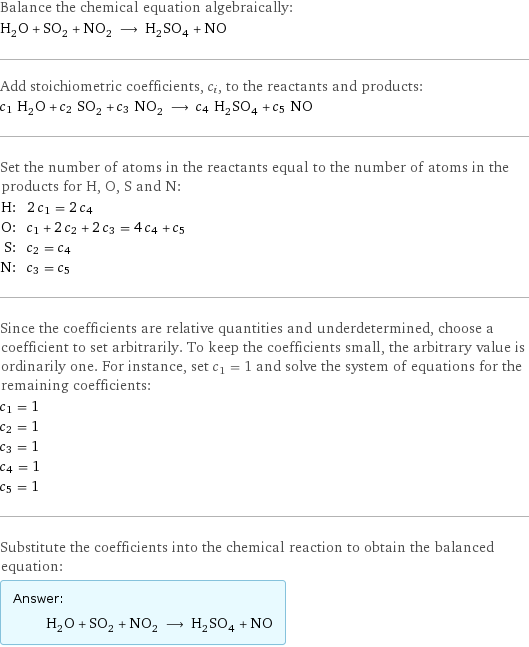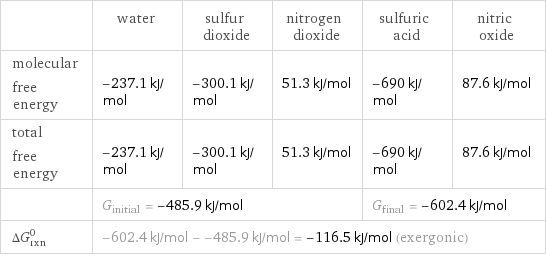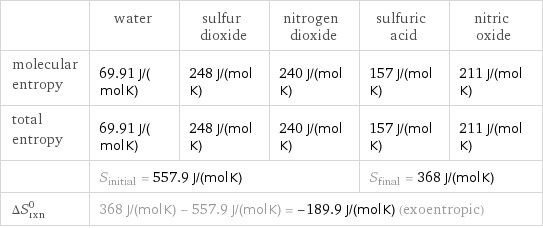Input interpretation

H_2O water + SO_2 sulfur dioxide + NO_2 nitrogen dioxide ⟶ H_2SO_4 sulfuric acid + NO nitric oxide
Balanced equation

Balance the chemical equation algebraically: H_2O + SO_2 + NO_2 ⟶ H_2SO_4 + NO Add stoichiometric coefficients, c_i, to the reactants and products: c_1 H_2O + c_2 SO_2 + c_3 NO_2 ⟶ c_4 H_2SO_4 + c_5 NO Set the number of atoms in the reactants equal to the number of atoms in the products for H, O, S and N: H: | 2 c_1 = 2 c_4 O: | c_1 + 2 c_2 + 2 c_3 = 4 c_4 + c_5 S: | c_2 = c_4 N: | c_3 = c_5 Since the coefficients are relative quantities and underdetermined, choose a coefficient to set arbitrarily. To keep the coefficients small, the arbitrary value is ordinarily one. For instance, set c_1 = 1 and solve the system of equations for the remaining coefficients: c_1 = 1 c_2 = 1 c_3 = 1 c_4 = 1 c_5 = 1 Substitute the coefficients into the chemical reaction to obtain the balanced equation: Answer: | | H_2O + SO_2 + NO_2 ⟶ H_2SO_4 + NO
Structures

+ + ⟶ +
Names

water + sulfur dioxide + nitrogen dioxide ⟶ sulfuric acid + nitric oxide
Reaction thermodynamics
Enthalpy

| water | sulfur dioxide | nitrogen dioxide | sulfuric acid | nitric oxide molecular enthalpy | -285.8 kJ/mol | -296.8 kJ/mol | 33.2 kJ/mol | -814 kJ/mol | 91.3 kJ/mol total enthalpy | -285.8 kJ/mol | -296.8 kJ/mol | 33.2 kJ/mol | -814 kJ/mol | 91.3 kJ/mol | H_initial = -549.4 kJ/mol | | | H_final = -722.7 kJ/mol | ΔH_rxn^0 | -722.7 kJ/mol - -549.4 kJ/mol = -173.3 kJ/mol (exothermic) | | | |
Gibbs free energy

| water | sulfur dioxide | nitrogen dioxide | sulfuric acid | nitric oxide molecular free energy | -237.1 kJ/mol | -300.1 kJ/mol | 51.3 kJ/mol | -690 kJ/mol | 87.6 kJ/mol total free energy | -237.1 kJ/mol | -300.1 kJ/mol | 51.3 kJ/mol | -690 kJ/mol | 87.6 kJ/mol | G_initial = -485.9 kJ/mol | | | G_final = -602.4 kJ/mol | ΔG_rxn^0 | -602.4 kJ/mol - -485.9 kJ/mol = -116.5 kJ/mol (exergonic) | | | |
Entropy

| water | sulfur dioxide | nitrogen dioxide | sulfuric acid | nitric oxide molecular entropy | 69.91 J/(mol K) | 248 J/(mol K) | 240 J/(mol K) | 157 J/(mol K) | 211 J/(mol K) total entropy | 69.91 J/(mol K) | 248 J/(mol K) | 240 J/(mol K) | 157 J/(mol K) | 211 J/(mol K) | S_initial = 557.9 J/(mol K) | | | S_final = 368 J/(mol K) | ΔS_rxn^0 | 368 J/(mol K) - 557.9 J/(mol K) = -189.9 J/(mol K) (exoentropic) | | | |
Equilibrium constant
![Construct the equilibrium constant, K, expression for: H_2O + SO_2 + NO_2 ⟶ H_2SO_4 + NO Plan: • Balance the chemical equation. • Determine the stoichiometric numbers. • Assemble the activity expression for each chemical species. • Use the activity expressions to build the equilibrium constant expression. Write the balanced chemical equation: H_2O + SO_2 + NO_2 ⟶ H_2SO_4 + NO Assign stoichiometric numbers, ν_i, using the stoichiometric coefficients, c_i, from the balanced chemical equation in the following manner: ν_i = -c_i for reactants and ν_i = c_i for products: chemical species | c_i | ν_i H_2O | 1 | -1 SO_2 | 1 | -1 NO_2 | 1 | -1 H_2SO_4 | 1 | 1 NO | 1 | 1 Assemble the activity expressions accounting for the state of matter and ν_i: chemical species | c_i | ν_i | activity expression H_2O | 1 | -1 | ([H2O])^(-1) SO_2 | 1 | -1 | ([SO2])^(-1) NO_2 | 1 | -1 | ([NO2])^(-1) H_2SO_4 | 1 | 1 | [H2SO4] NO | 1 | 1 | [NO] The equilibrium constant symbol in the concentration basis is: K_c Mulitply the activity expressions to arrive at the K_c expression: Answer: | | K_c = ([H2O])^(-1) ([SO2])^(-1) ([NO2])^(-1) [H2SO4] [NO] = ([H2SO4] [NO])/([H2O] [SO2] [NO2])](../image_source/0dc9a78c87b78a79a0ab8ab86116ab34.png)
Construct the equilibrium constant, K, expression for: H_2O + SO_2 + NO_2 ⟶ H_2SO_4 + NO Plan: • Balance the chemical equation. • Determine the stoichiometric numbers. • Assemble the activity expression for each chemical species. • Use the activity expressions to build the equilibrium constant expression. Write the balanced chemical equation: H_2O + SO_2 + NO_2 ⟶ H_2SO_4 + NO Assign stoichiometric numbers, ν_i, using the stoichiometric coefficients, c_i, from the balanced chemical equation in the following manner: ν_i = -c_i for reactants and ν_i = c_i for products: chemical species | c_i | ν_i H_2O | 1 | -1 SO_2 | 1 | -1 NO_2 | 1 | -1 H_2SO_4 | 1 | 1 NO | 1 | 1 Assemble the activity expressions accounting for the state of matter and ν_i: chemical species | c_i | ν_i | activity expression H_2O | 1 | -1 | ([H2O])^(-1) SO_2 | 1 | -1 | ([SO2])^(-1) NO_2 | 1 | -1 | ([NO2])^(-1) H_2SO_4 | 1 | 1 | [H2SO4] NO | 1 | 1 | [NO] The equilibrium constant symbol in the concentration basis is: K_c Mulitply the activity expressions to arrive at the K_c expression: Answer: | | K_c = ([H2O])^(-1) ([SO2])^(-1) ([NO2])^(-1) [H2SO4] [NO] = ([H2SO4] [NO])/([H2O] [SO2] [NO2])
Rate of reaction
![Construct the rate of reaction expression for: H_2O + SO_2 + NO_2 ⟶ H_2SO_4 + NO Plan: • Balance the chemical equation. • Determine the stoichiometric numbers. • Assemble the rate term for each chemical species. • Write the rate of reaction expression. Write the balanced chemical equation: H_2O + SO_2 + NO_2 ⟶ H_2SO_4 + NO Assign stoichiometric numbers, ν_i, using the stoichiometric coefficients, c_i, from the balanced chemical equation in the following manner: ν_i = -c_i for reactants and ν_i = c_i for products: chemical species | c_i | ν_i H_2O | 1 | -1 SO_2 | 1 | -1 NO_2 | 1 | -1 H_2SO_4 | 1 | 1 NO | 1 | 1 The rate term for each chemical species, B_i, is 1/ν_i(Δ[B_i])/(Δt) where [B_i] is the amount concentration and t is time: chemical species | c_i | ν_i | rate term H_2O | 1 | -1 | -(Δ[H2O])/(Δt) SO_2 | 1 | -1 | -(Δ[SO2])/(Δt) NO_2 | 1 | -1 | -(Δ[NO2])/(Δt) H_2SO_4 | 1 | 1 | (Δ[H2SO4])/(Δt) NO | 1 | 1 | (Δ[NO])/(Δt) (for infinitesimal rate of change, replace Δ with d) Set the rate terms equal to each other to arrive at the rate expression: Answer: | | rate = -(Δ[H2O])/(Δt) = -(Δ[SO2])/(Δt) = -(Δ[NO2])/(Δt) = (Δ[H2SO4])/(Δt) = (Δ[NO])/(Δt) (assuming constant volume and no accumulation of intermediates or side products)](../image_source/53cb12dd711472caa3b531f28ba50b43.png)
Construct the rate of reaction expression for: H_2O + SO_2 + NO_2 ⟶ H_2SO_4 + NO Plan: • Balance the chemical equation. • Determine the stoichiometric numbers. • Assemble the rate term for each chemical species. • Write the rate of reaction expression. Write the balanced chemical equation: H_2O + SO_2 + NO_2 ⟶ H_2SO_4 + NO Assign stoichiometric numbers, ν_i, using the stoichiometric coefficients, c_i, from the balanced chemical equation in the following manner: ν_i = -c_i for reactants and ν_i = c_i for products: chemical species | c_i | ν_i H_2O | 1 | -1 SO_2 | 1 | -1 NO_2 | 1 | -1 H_2SO_4 | 1 | 1 NO | 1 | 1 The rate term for each chemical species, B_i, is 1/ν_i(Δ[B_i])/(Δt) where [B_i] is the amount concentration and t is time: chemical species | c_i | ν_i | rate term H_2O | 1 | -1 | -(Δ[H2O])/(Δt) SO_2 | 1 | -1 | -(Δ[SO2])/(Δt) NO_2 | 1 | -1 | -(Δ[NO2])/(Δt) H_2SO_4 | 1 | 1 | (Δ[H2SO4])/(Δt) NO | 1 | 1 | (Δ[NO])/(Δt) (for infinitesimal rate of change, replace Δ with d) Set the rate terms equal to each other to arrive at the rate expression: Answer: | | rate = -(Δ[H2O])/(Δt) = -(Δ[SO2])/(Δt) = -(Δ[NO2])/(Δt) = (Δ[H2SO4])/(Δt) = (Δ[NO])/(Δt) (assuming constant volume and no accumulation of intermediates or side products)
Chemical names and formulas

| water | sulfur dioxide | nitrogen dioxide | sulfuric acid | nitric oxide formula | H_2O | SO_2 | NO_2 | H_2SO_4 | NO Hill formula | H_2O | O_2S | NO_2 | H_2O_4S | NO name | water | sulfur dioxide | nitrogen dioxide | sulfuric acid | nitric oxide IUPAC name | water | sulfur dioxide | Nitrogen dioxide | sulfuric acid | nitric oxide